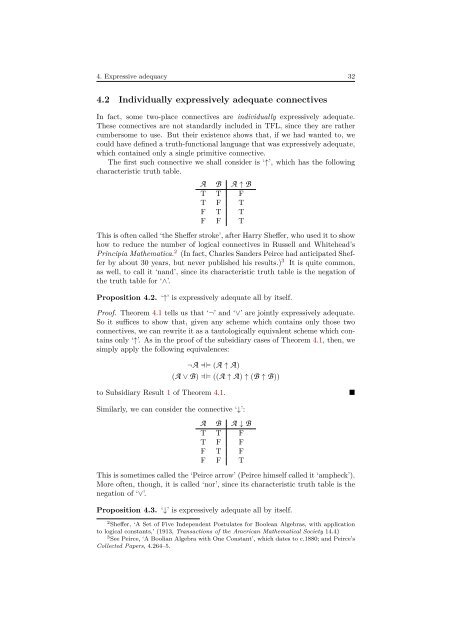Metatheory - University of Cambridge
Metatheory - University of Cambridge
Metatheory - University of Cambridge
You also want an ePaper? Increase the reach of your titles
YUMPU automatically turns print PDFs into web optimized ePapers that Google loves.
4. Expressive adequacy 32<br />
4.2 Individually expressively adequate connectives<br />
In fact, some two-place connectives are individually expressively adequate.<br />
These connectives are not standardly included in TFL, since they are rather<br />
cumbersome to use. But their existence shows that, if we had wanted to, we<br />
could have defined a truth-functional language that was expressively adequate,<br />
which contained only a single primitive connective.<br />
The first such connective we shall consider is ‘↑’, which has the following<br />
characteristic truth table.<br />
A B A ↑ B<br />
T T F<br />
T F T<br />
F T T<br />
F F T<br />
This is <strong>of</strong>ten called ‘the Sheffer stroke’, after Harry Sheffer, who used it to show<br />
how to reduce the number <strong>of</strong> logical connectives in Russell and Whitehead’s<br />
Principia Mathematica. 2 (In fact, Charles Sanders Peirce had anticipated Sheffer<br />
by about 30 years, but never published his results.) 3 It is quite common,<br />
as well, to call it ‘nand’, since its characteristic truth table is the negation <strong>of</strong><br />
the truth table for ‘∧’.<br />
Proposition 4.2. ‘↑’ is expressively adequate all by itself.<br />
Pro<strong>of</strong>. Theorem 4.1 tells us that ‘¬’ and ‘∨’ are jointly expressively adequate.<br />
So it suffices to show that, given any scheme which contains only those two<br />
connectives, we can rewrite it as a tautologically equivalent scheme which contains<br />
only ‘↑’. As in the pro<strong>of</strong> <strong>of</strong> the subsidiary cases <strong>of</strong> Theorem 4.1, then, we<br />
simply apply the following equivalences:<br />
¬A<br />
(A ∨ B)<br />
⊨<br />
⊨<br />
⊨ (A ↑ A)<br />
⊨ ((A ↑ A) ↑ (B ↑ B))<br />
to Subsidiary Result 1 <strong>of</strong> Theorem 4.1.<br />
■<br />
Similarly, we can consider the connective ‘↓’:<br />
A B A ↓ B<br />
T T F<br />
T F F<br />
F T F<br />
F F T<br />
This is sometimes called the ‘Peirce arrow’ (Peirce himself called it ‘ampheck’).<br />
More <strong>of</strong>ten, though, it is called ‘nor’, since its characteristic truth table is the<br />
negation <strong>of</strong> ‘∨’.<br />
Proposition 4.3. ‘↓’ is expressively adequate all by itself.<br />
2 Sheffer, ‘A Set <strong>of</strong> Five Independent Postulates for Boolean Algebras, with application<br />
to logical constants,’ (1913, Transactions <strong>of</strong> the American Mathematical Society 14.4)<br />
3 See Peirce, ‘A Boolian Algebra with One Constant’, which dates to c.1880; and Peirce’s<br />
Collected Papers, 4.264–5.
















